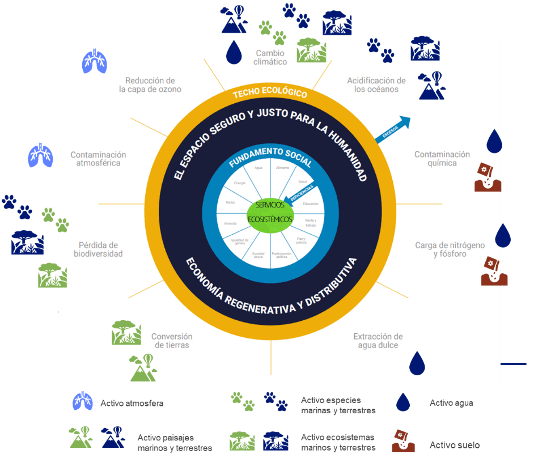Scientists including Johan Röckstrom and economists such as Kate Raworth have contributed to shaping the concepts of a safe and just operating space and its practical translation into "doughnut economics". The doughnut is the result of establishing minimum thresholds for intervention in ecosystems in order to meet the demands of the people who depend on them internally, and externally, defining maximum thresholds that each ecosystem can provide while remaining sustainable.
What is the safe operating space?
The space between these minimum and maximum levels is known as the safe operating space, in which people's and ecosystems' health is not endangered, and the just operating space, as it recognises the needs of the people who depend on the territory.
How is the safe operating space for the management of specific ecosystems and territories created?
In order to achieve this, we must understand and quantify the systemic logic and dynamics of each territory and each ecosystem service it provides. This understanding is obviously the result of gathering relevant information. When they are analysed and interpreted, these data provide a specific vision of each of these services, for obtaining a more comprehensive understanding of the dynamics and interactions that take place in the social-ecological system.
After ascertaining the sustainable supply of water, arable land, wood, etc. within the planet's limits, it is possible to plan how each of these services can be used within this safe space.
The planet's limits in turn form the basis of projects such as Science Based Targets and Science Based Targets for Nature, which establish goals based on not exceeding those limits, and taking full advantage of the opportunities provided by the use of nature-based solutions to climate change. Breakthroughs in this field are showing that these solutions are often more effective and efficient than those based solely on infrastructure.
The holistic vision provided by an integration of the driving forces behind biodiversity loss and society's need to consider solutions to climate change and other major problems, enables the efforts made by a company to act responsibly with the natural capital and the social contribution provided by that effort to be integrated into a framework for evaluation, thereby confirming that its value proposal and business model generate economic growth that is sustainable over time, responsible and resilient to risks.
The concept of co-benefits, which the IPCC formulates based on the perspective of climate change to refer to the benefits created by the fight against climate change in other areas such as the economic and social spheres, does not fully reflect the extent of the opportunities in the integration of an approach that designs, measures and evaluates the management of the natural and industrial heritage in its entirety.
Each of the system's nine risk engines is linked to at least one or more natural assets in natural capital, forming a network of interactions that is complex but fully understandable with modern information technologies.
The social foundations are the minimum requirements that the society directly linked to the territory demands or needs to see met for its social and economic development, and are provided by the ecosystem services and business itself.
Any project aimed at the sustainability of natural assets will create a benefit for society by improving the provision of ecosystem services in the long term. Any project for social responsibility, or the enhancement or improvement of the production model, will lead to an appreciation in value of natural capital through the sustainability of natural assets and an improvement in the provision of ecosystem services.

Finally, any initiative aimed at improving economic performance within the safe operating space will contribute to increasing the valuation of the ecosystem services on which it is based and the natural assets that produce them, thereby contributing to their conservation and sustainability.